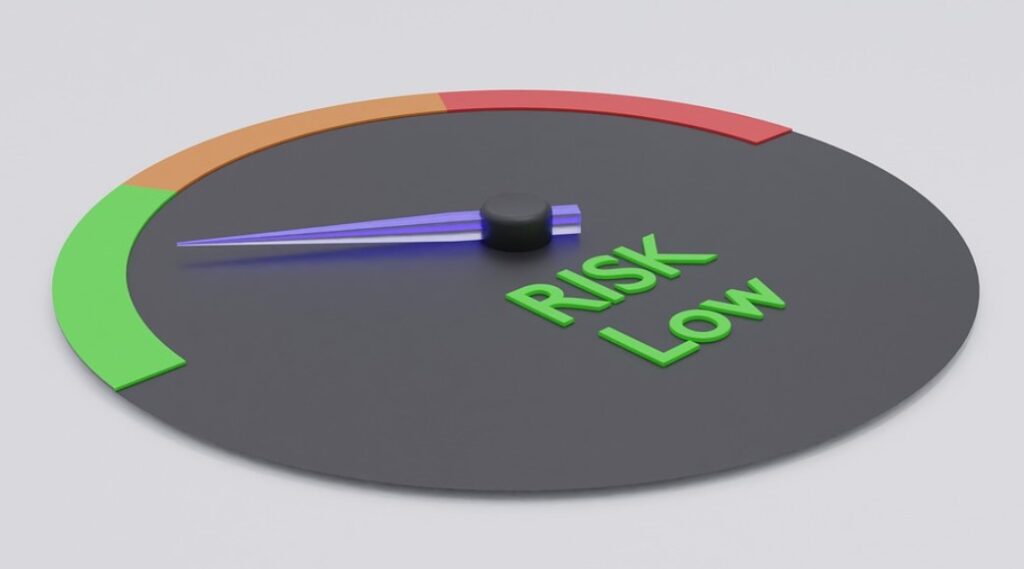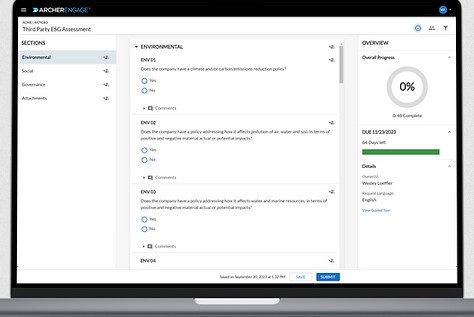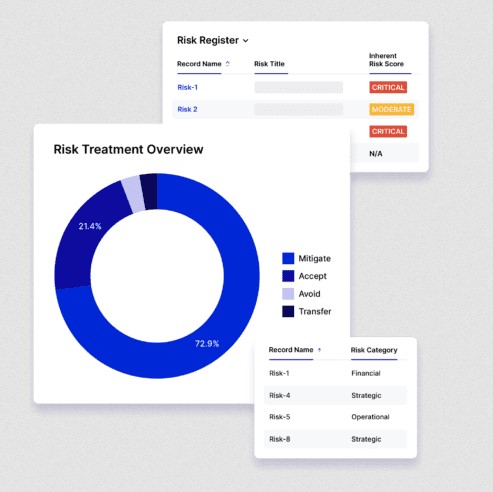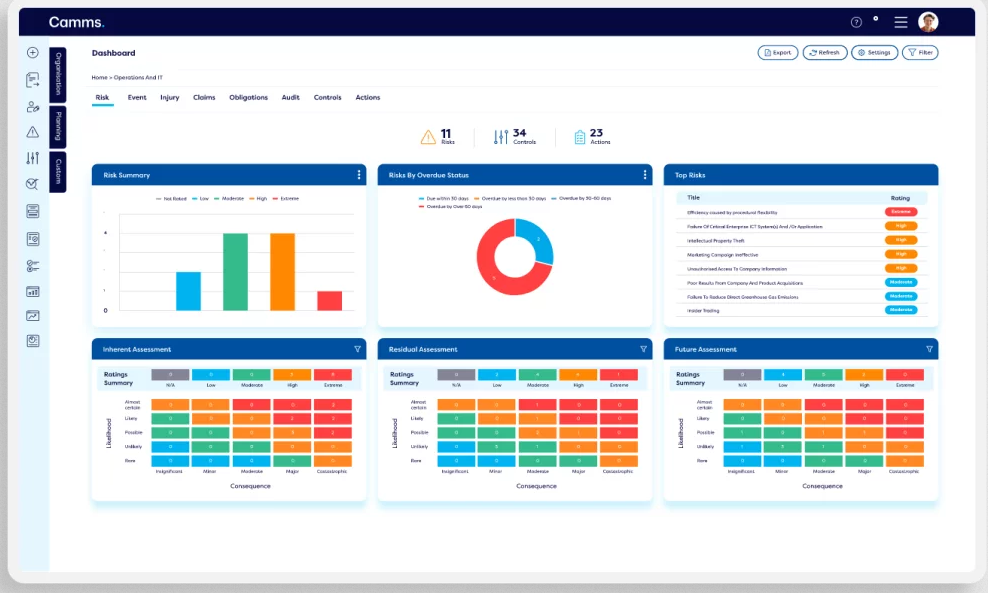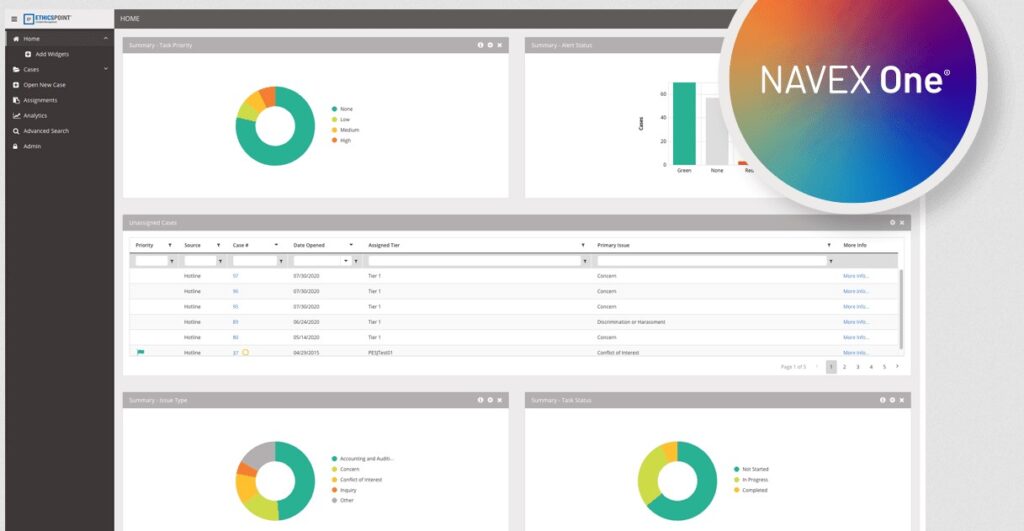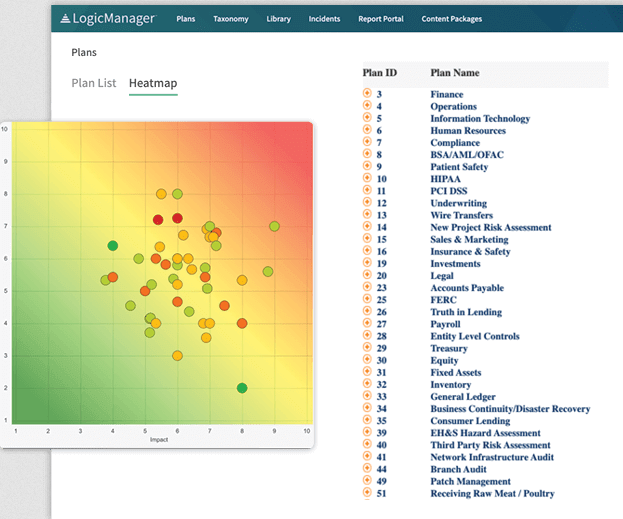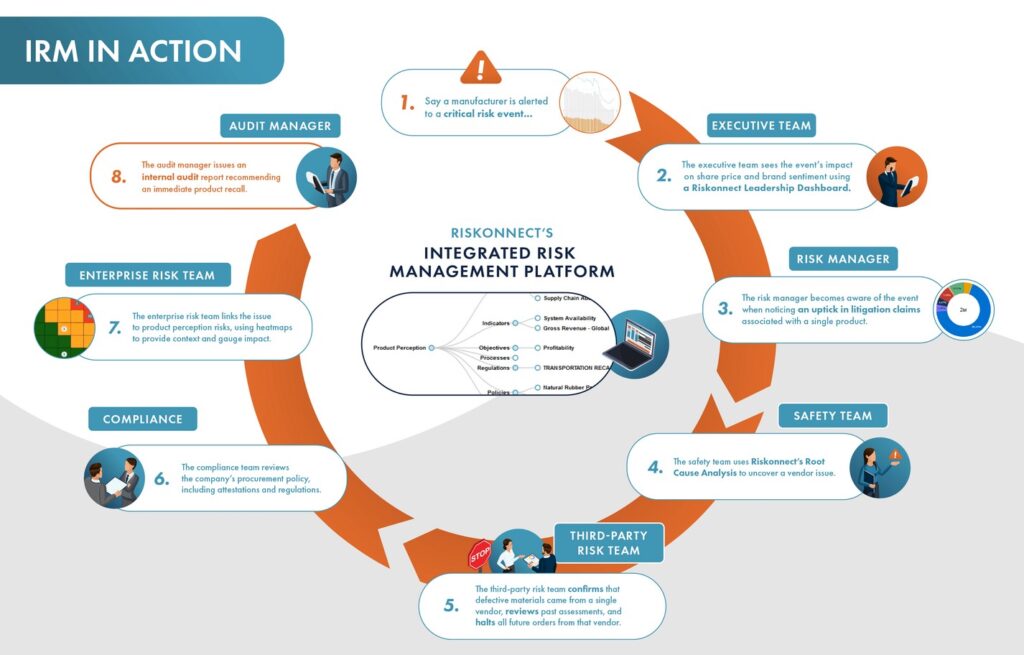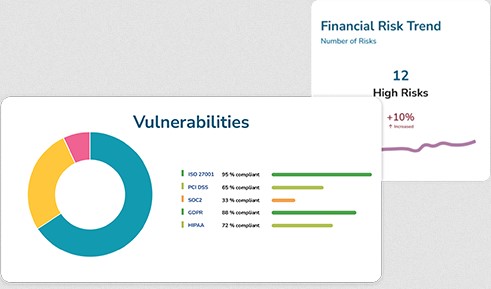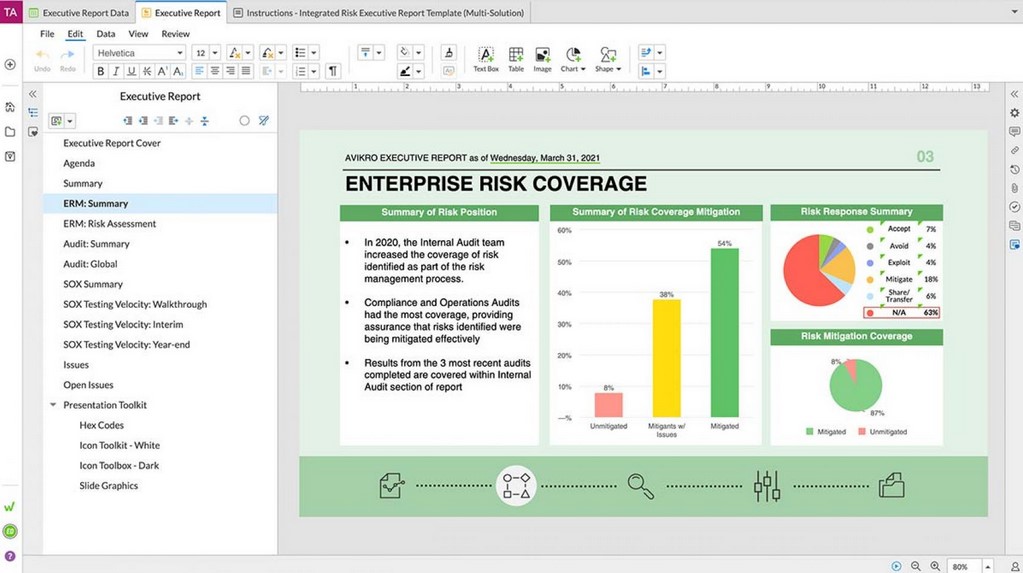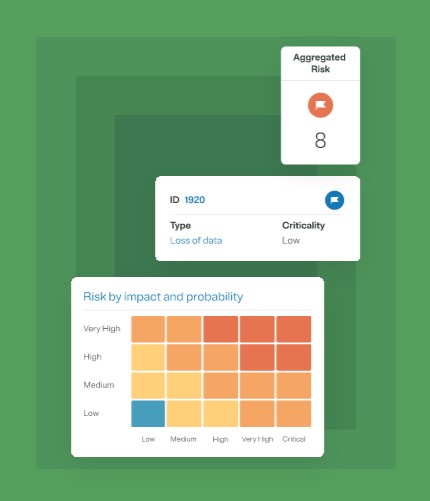Enterprise risks are increasing by the day. According to a study by ISACA, the world’s leading institute for digital trust, 52% of companies are experiencing an increase in cyberattacks. Moreover, 65% of senior executives see an increase in corporate risks while 35% of executives are expecting an uptick in compliance and regulatory risks.
For organizations, navigating through these multiple risks is challenging because they often don’t have the systems and talent to handle them. To counter these shortcomings, they turn to Enterprise Risk Management (ERM) software.
Again, navigating through the ERM market to find the right tool is not easy, and hence, we have narrowed down the choices for you.
Here are some of the best ERM Platforms available today:
- Archer Engage An effective risk management software that streamlines risk handling while improving coordination and information sharing with key stakeholders.
- LogicGate An ERM that provides a planning-based approach to risk management. It uses AI-driven processes to improve overall business outcomes.
- Camms A platform that embeds risk culture within every aspect of your organization’s operations and enables you to confidently navigate the risk environment.
- NAVEX One An integrated GRC platform that supports collaboration while safeguarding your organization from regulatory and other risks.
- LogicManager A SaaS ERM that empowers organizations to understand risks and helps to monitor and mitigate them.
- Riskonnect A comprehensive risk management platform that reduces risks, increases efficiency and improves operational performance.
- SureCloud Aurora A GRC threat intelligence tool that enables a data-driven approach to mitigating risks and meeting compliance.
- Workiva A connected risk management platform that brings together risk data and real-time insights to provide all the information you need for policy making.
- OneTrust A specialized ERM tool for Trust Domains. It also provides greater visibility into an organization’s data privacy policies, risk factors, compliance levels, and more.
The Best Enterprise Risk Management Software
Our methodology for selecting a GRC Software Platform:
We used some important factors to decide which tools are better than the others. These factors are:
- Analytics and reports: We believe not everyone has the time or the skills to understand the technical aspects of risk management. This is why it’s important for a tool to generate intuitive reports and analytics to provide executives with a glance at the issues. However, the tool must also have the option to go in-depth if users want to analyze any particular aspect.
- Integrations: The selected ERM must integrate easily with any tech stack to reduce the setup and installation hassles.
- Customization and flexibility: An ERM tool must offer flexibility to customize configurations to meet the specific risks of different organizations.
- Scalable: The risk management platform should seamlessly grow with the business.
- Compliance: It’s good to have tools that not only manage risks but also help with regulatory compliance.
Now that you know the logic behind our selection, let’s jump into the tools.
1. Archer Engage
Archer Engage is an effective risk management platform that goes beyond processes and tools for risk management. It engages people by assigning responsibilities, coordinating and collaborating on tasks, and sharing information with key business users. Such an engaged approach reduces risks and gets everyone involved.
Source: Archer
Here’s a look at Archer Engage’s key features.
Intuitive User Interface
The first step to involving different users is to have a simple and intuitive user interface and Engage scores well in this aspect. Users can get a quick peek into the status of risk activities and can navigate around to find what they want. It also supports two-way communication between risk teams and other users.
Data-driven Approach
Engage takes a data-driven approach to risk management. It captures data from different sources and feeds them to the main Archer platform where the data is converted into meaningful insights. Such an approach provides a comprehensive idea of the risks and their expected impact.
Report Generation
Business users can get well-designed and detailed reports through Engage. With such insights, executives can make informed decisions on the required policies and investments.
Overall, Engage streamlines risk management by gathering data, analyzing them, and presenting them in an easy-to-understand format.
Pros:
- Flexible deployment.
- Additional tools for business continuity.
- Documents governance.
- Complies with regulations in the U.S., UK, Europe, and Australia.
Cons:
- Expensive
- No support for PDF or PowerPoint.
2. LogicGate
LogicGate provides comprehensive visibility into risks to enable you to plan and implement appropriate strategies. It assesses internal and external environments to identify and prioritize the risks while its automation can reduce manual efforts in many risk mitigation processes.
Source: LogicGate
Below are the key capabilities of LogicGate.
Automates Workflows
LogicGate eliminates manual work by automating many tedious tasks and processes. It automates risk scoring and creates actionable items for risk management. Its workflows, reminders, and notifications help monitor the progress.
Scalable and Configurable
This ERM tool is easy to configure. Its graph database dynamically connects risks and controls to different business units and their owners, making it highly flexible. Also, LogicGate scales well with your growing business.
Custom Dashboards
LogicGate keeps executives and other key stakeholders engaged with its well-designed dashboards and reports. There are hundreds of pre-built reports that provide information about risk controls, mitigation strategies, the nature of risks, and other data for the executives.
With such advanced features, LogicGate streamlines the risk management process and protects organizations from the impact of risks.
Pros:
- Enables you to understand vendor risks.
- Automates many GRC processes.
- Helps manage multiple risks.
- A vast library of templates and applications.
Cons:
- Logging is not detailed.
- Limited documentation.
3. Camms
Camms is an industry-recognized risk management platform that strives to build a risk culture within your organization. It works with your organizational structure to empower every employee to contribute towards your organization’s ability to avert and mitigate risks.
Source: Camms
Let’s take a detailed look into Camms’ capabilities.
Risk Registers
Risk registers are the central repository for recording risks and their related information. Camms creates these risk registers (if you don’t already have one) and adds pertinent information to them. As a result, you can get the risk-related data you need within minutes while also providing comprehensive visibility into risk mitigation efforts.
Control Frameworks
Control frameworks are another key aspect of risk management as they align risks with your organization’s controls. This framework is also a critical aspect of many leading regulations like SOX and ISO 31000. Camms creates control frameworks where risks are linked to controls through bow-tie visualizations.
Governance and Security
Governance and security are essential aspects of risk management. With Camms, you can customize and change your governance policies to the evolving risks. Also, you can present different views of risk management to different employees, based on the role.
All these features make Camms one of the leading platforms for risk management and reporting.
Pros:
- Good dashboard and reporting features.
- Integrates well with multiple modules.
- Excellent customer support.
- Adaptable for your organization’s needs.
Cons:
- Can be slow at times.
- Limited training and documentation.
4. NAVEX One
NAVEX One is a Governance, Risk, and Compliance (GRC) platform that encourages collaboration and security within your organization. It brings together your employees, third-party vendors, and business processes to make your organization compliant with regulatory requirements while safeguarding it from the potential risks coming from multiple sources.
Source: NAVEX
Below are NAVEX One’s important features.
Automated Risk and Compliance Processes
NAVEX One automates your risk and compliance processes by building a sustainable security information system that contains all the information related to your risks. Also, it continuously identifies and mitigates risks through its processes.
Handling Third-Party Risks
Third-party risks are the blindspots for many organizations. To eliminate this unknown, NAVEX One simplifies onboarding for your vendors and third-party service providers. It also analyzes the ESG commitments of your vendor organizations and helps plan for business interruptions.
Informed Decision Making
NAVEX One supports a culture of informed decision-making. It aggregates data from different sources into a single platform to provide unified views of your risks and the impact of your mitigation strategies. Similarly, it also measures compliance programs against the standards to identify deviations.
Overall, NAVEX One eases the pressure of identifying risks and meeting compliance with its automated data gathering and evaluation processes.
Pros:
- Provides easy access to GRC policies.
- Built-in security for all GRC activities.
- Improves efficiency with its workflows.
- Reviews and updates compliance regulations.
Cons:
- Can be expensive
- Limited integrations.
5. LogicManager
LogicManager is a cloud-based risk management software that helps you understand existing and emerging risks and prepares you to handle them. Through its many features, LogicManager improves business performance and reduces the costs associated with risk management with its many specialized modules.
Source: LogicManager
Here’s a look into a few modules of LogicManager.
Enterprise Policy Management
LogicManager has an enterprise policy management module to centralize the information about risk policies and their implementation. Its comprehensive visibility helps security teams update these policies as new risks emerge while monitoring the effectiveness of each policy.
Enterprise Risk Assessment
With its comprehensive Risk Library, LogicManager organizes the common root causes of your risks. It even creates a heatmap to visualize the spread of these risks across different departments. Moreover, you can centralize the mitigation activities across the organization to share resources and monitor progress.
Risk Event Management
The Risk Event Management module gathers information about risks and aligns them with departments, vendors, and applications. Based on this mapping, you can create policies and monitor their progress against each risk.
Overall, LogicManager’s modular approach to risk management enables organizations to identify and remediate risks before they impact operations or security.
Pros:
- Good customer support.
- Friendly user interface.
- Easy to customize.
- Saves time and money.
Cons:
- Can be overwhelming for small businesses and non-technical users.
- The risk-scoring methodology can be more transparent.
6. Riskonnect
Riskonnect is a comprehensive risk management software that empowers organizations to anticipate risks based on the changing external and internal environments and stay prepared to manage them. It also helps organizations respond to these emerging risks in real-time.
Source: Riskonnect
Below is a list of Riskonnect’s key features.
Comprehensive View of Risks
A highlight of Riskonnect is its ability to gather information from many sources and connect the dots to provide a concrete picture of your risk environment. On this tool, you can see the full spectrum of risks across different areas like security, compliance, operations, and more.
Generative AI for Business Planning
Keeping in tune with emerging technologies, Riskonnect uses generative AI for business planning and continuity. With this technology, organizations can quickly identify their critical risks and assess their potential impact on business operations. It also simulates different scenarios to enhance your preparedness for such events.
Third-party Risk Management
Riskonnect evaluates the security status, financial strength, and risk levels of third-party service providers before you onboard them to your organization. Moreover, it centralizes all documents related to them, making it easy to check on security and compliance when needed.
In all, Riskonnect handles multiple aspects of risk management and even leverages new technologies to ensure continuity in business operations and cybersecurity.
Pros:
- Creates visual mapping of risks with controls for easy understanding.
- Sets priority for risks.
- Identifies risks across different areas of your business.
- Provides on-demand training to users.
Cons:
- Implementation can be cumbersome.
- No mobile app.
7. SureCloud Aurora
SureCloud Aurora simplifies all aspects of GRC and helps you confidently address a wide range of challenges associated with your organization’s operations, security, and compliance. It offers a modular approach where you can select the modules you want to include in your infrastructure.
Source: SureCloud
Let’s look at Aurora’s important features.
Provides Threat Intelligence
SureCloud Aurora removes the blindspots and inefficiencies associated with poor threat intelligence. It seamlessly integrates with your organization’s business tools, processes, third-party systems, and other aspects to collate data and analyze them for insights.
Dashboard and Reports
The intuitive dashboard and reports enable you to better calculate the effectiveness of your GRC programs, so you can make informed changes to existing policies. More importantly, it provides a snapshot of your organization’s current state and the progress made toward your goals.
Data Privacy Management
With Aurora, you can use its pre-built workflows to automate the process of assessing and improving data privacy within your organization. You can also document your findings and generate status reports – all of which can help to comply with regulations like GDPR and HIPAA.
Overall, SureCloud Aurora is a modules-based tool that provides the flexibility to add the GRC capabilities you need.
Pros:
- Highly customizable.
- Excellent customer support.
- Enables you to identify and respond to issues quickly.
- Focuses on privacy.
Cons:
- The interface can be confusing.
- Complex dashboard filters.
8. Workiva
Workiva is an ERM tool that brings together your risk data and real-time insights to enable you to create relevant policies for risk mitigation. It also ties together controls, audit trails, and assessments to provide a holistic view of your risk environment.
Source: Workiva
The key features of Workiva are:
Real-time Collaboration
A standout feature of Workiva is its real-time collaboration. It brings data from different risk owners into a single secure location to centralize information for risk assessment and policy making. It also updates this data in real-time to ensure you’re on top of events as they happen.
Data Collection and Analysis
Workiva gathers historical data and leverages the latest information to create dynamic data views that provide a clear picture of your risks. Moreover, it also creates a robust audit trail to track risks.
Maps Controls and Risks
This platform brings together your internal controls and maps them with risks. As a result, you can automate processes and have better control over your internal controls. You can even use this information to create transparent and meaningful reports.
With such features, Workiva is undoubtedly a handy ERM platform for organizations using a data-driven approach to risk management.
Pros:
- Automated reminders and notifications
- Real-time data views.
- Process automation.
- Detailed analytics.
Cons:
- Steep learning curve.
- Generating audit reports is not intuitive.
9. OneTrust
OneTrust is a unified ERM that maps the variable and fixed risks associated with your business across your operational areas. This mapping helps you to pinpoint specific risks and assign responsibilities to appropriate individuals or teams.
Source: OneTrust
Below are the salient features of OneTrust ERM.
Connected Insights
OneTrust is best known for its connected insights that provide the context for each risk. With such a unified view, OneTrust removes the noise surrounding your data, so you can focus on the information that matters.
Prioritized Risks
Risk registers in your organization provide all the information in one place and prioritize them based on their likely impact. Based on this score, you can allocate resources and address the most critical ones first.
Streamlining of Policies
With OneTrust, you can draft policies, review them, and get the necessary approvals for implementing them. Also, you can track their implementation and manage exceptions – all through a single dashboard.
In all, OneTrust focuses on providing the right data and insights to help you make the right decisions.
Pros:
- Automates assessments.
- Views even fourth and fifth-party risks to provide a unified view.
- Data mapping is useful
- Safe and reliable.
Cons:
- Limited workflow customization.
- No consultation services.
Thus, these are the best risk management software.
Bottom Line
To conclude, risks are present everywhere and the best way for organizations to foresee them and make plans to mitigate their impact is through well-developed risk management software. In this article, we discussed the best enterprise risk management tools that work well for large and global enterprises. Make sure to select a tool based on your specific requirements.
